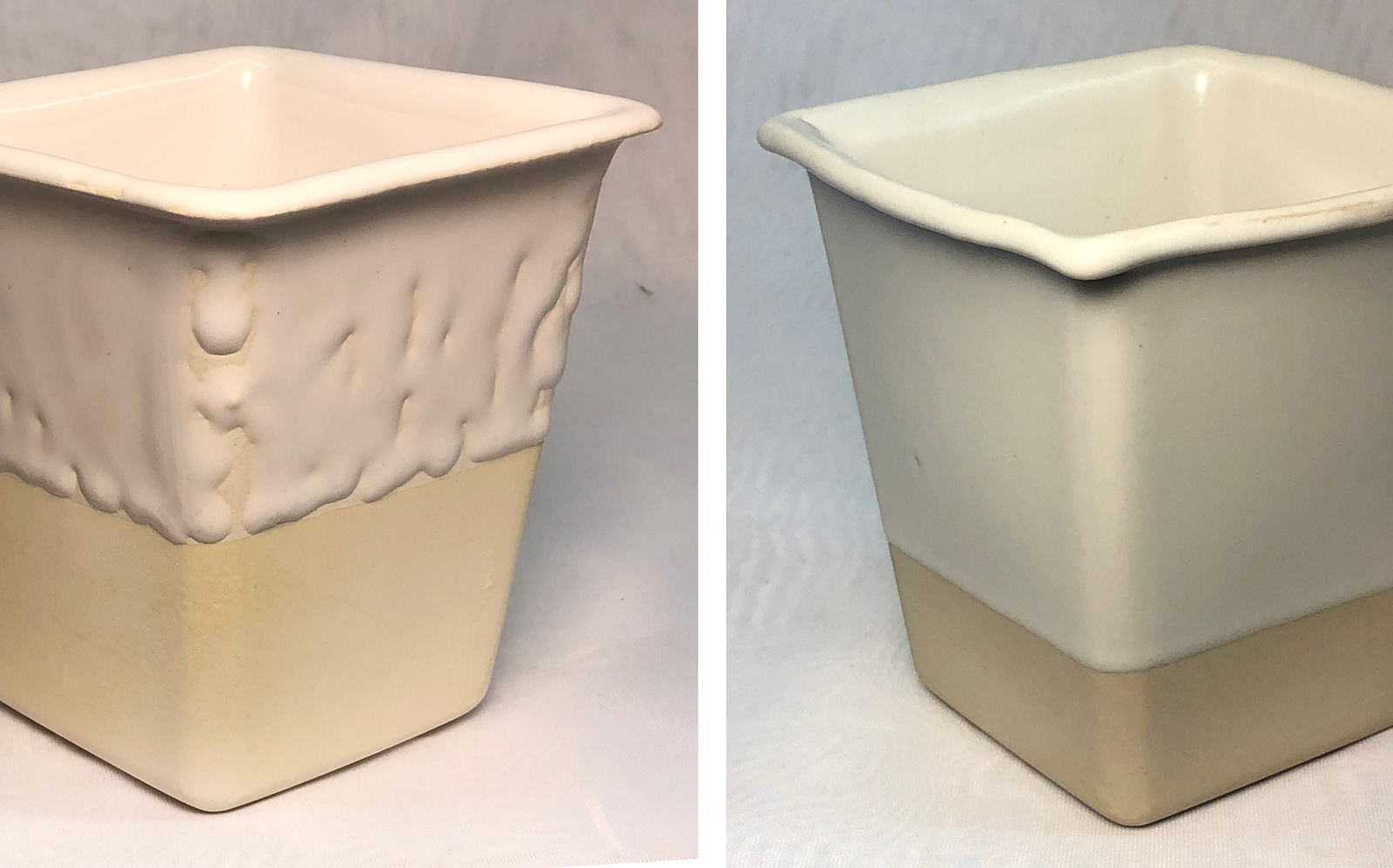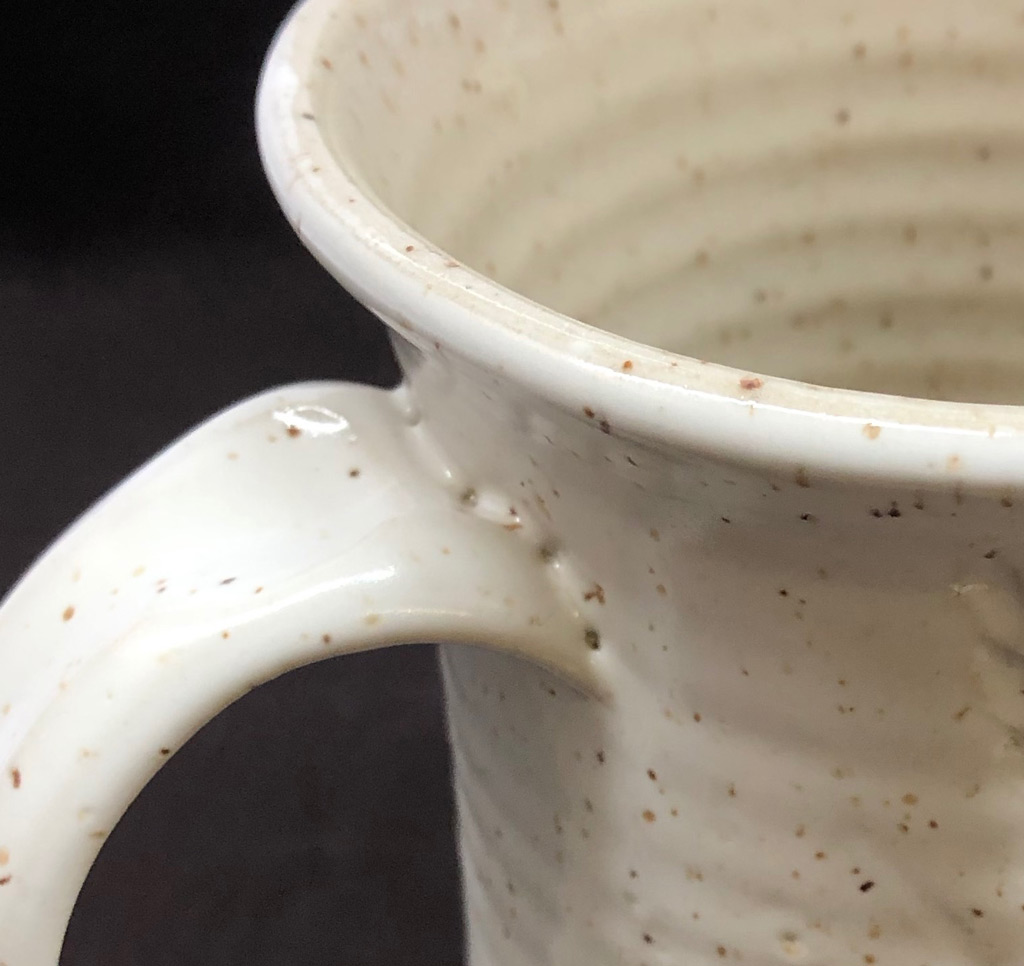| Monthly Tech-Tip | No tracking! No ads! | |
Crawling in G2934Y Zircopax white glaze: Here are some fixes.
G2934Y, a variation of the G2934 base, is a good stain matte base glaze but it is not without issues. It has significant clay content in the recipe and high levels of Al2O3 in the chemistry, these make it susceptible to crawling. This base is normally fine as is but when opacified or certain stains are added (especially at significant percentages) it can crawl. This has 10% Zircopax. Even though the glaze layer thickens at the recess of the handle join it is still crawling. We also get this on the insides of mugs where wall and foot meet at a sharp angle. This was initiated because the glaze cracked here during drying. Normally it would heal but the zircon stiffens the melt, making it less mobile. The easiest solution is to adjust the specific gravity of the glaze to 1.44 and flocculate it to thixotropic, this assures that the application is not too thick. Another measure is to add a little CMC gum (by replacing some of the water with gum solution). Lastly, use a blend of tin oxide and Zircopax, as in the G3926C version of the recipe, to opacify it.
Related Pictures
ChatGPT is surprisingly wrong about the causes of glaze crawling.

This picture has its own page with more detail, click here to see it.
ChatGPT trained on the entire internet and yet gave 100% wrong answers and neglected the key thing that causes 90% of crawling! How can the internet be so wrong? Consider the suggestions it gave:
-Dust or oil on the bisque: This almost never happens. Besides, glaze is a mix of dust and water!
-Too much feldspar in a glaze can cause it to shrink excessively during firing: No, high feldspar causes thermal expansion/contraction of the fired glass, not physical shrinkage of the melt.
-If the clay body surface is not roughened, the glaze may not adhere properly: No, glazes don’t crawl any more on porcelains than other bodies.
-If the glaze is too thick in some areas and too thin in others, it can crawl in the thin areas: No, it crawls where thick because that’s where it cracks during drying.
-Over-firing or under-firing: No. Glazes fired to the ideal temperature crawl just as much.
-If the pottery is dried evenly or the drying process is too rapid: No, rapid drying of glaze on bisque is important to prevent cracking.
This crawling happened because the glaze cracked along the inside of that corner during drying. Such cracking is by far the number one cause of crawling, the melt pulls back from either side of the crack. The specific gravity of the slurry was too high, the resulting greater thickness right at the corner gave the shrinking glaze power to pull a crack. Adding water to bring the SG back down to 1.4 and then Epsom salts to gel it to thixotropic gave the slurry much better dipping and drying properties and totally solved this issue.
Crawling on sanitary ware. Laydown is the first suspect.

This picture has its own page with more detail, click here to see it.
This is glaze crawling and it underscores the need for attention to the details of all production parameters. This one small glaze defect makes this pedestal sink either a refire, a second or unsaleable. This is most common on abrupt surface contours but that is not the case here. The cause of this is likely several factors combining. The glaze is opaque white because it contains a high percentage of zircon opacifier. Zircon glazes tend to do exactly this so their successful use is doubly dependent on minimizing the percentage added and on attention to other details to compensate. This glaze has been applied thickly to ensure good coverage (thicker laydowns bring more crawling problems). The glaze is likely low in clay and thus the physical bond of the dried glaze layer depends on the binders being used, their percentages, the integrity of the way they were mixed in, and their shelf life. The ability of the glaze laydown to dry-bond with the body depends on the condition of the surface (e.g. water content, dry or bisque fired, smoothness, dustfreeness, quality of materials used in the body and integrity of body preparation, etc), the presence of surface contaminants (e.g. soluble salts) and the way in which it was applied and its thickness. The glaze melt's ability fire-bond and form an interface with the body that produces a smooth surface is dependent on its melt fluidity and ability to form an interface with the body.
There is another way to look at this problem: The process runs along crawling multiple tipping points: A viscous glaze melt, glaze application to dry rather than bisque ware, a thick glaze application, a large surface area intolerant of any defects and a glaze application technique (spraying) prone to irregularities of thickness. Rather than trying to identify the specific problem it might be better to simply make changes to move the process back from the tipping points.
This serious glaze crawling problem was solved with a simple addition

This picture has its own page with more detail, click here to see it.
This is G2934Y white (with 10% Zircopax). I initially blamed the zircon for the crawling. But, since the slurry had settled somewhat I was able to remove about 15% of the water and replace it with CMC gum solution. The gum addition was not enough to slow down the drying much but it really improved reduced the problem! This likely means that adherence of the dried layer to the smooth bisque was the issue. This being said, there were still a couple of small spots where it crawled. The ultimate solution thus appears to be discovering the percentage of CMC gum and water needed to get the least loss of drying speed and while achieving integrity of glaze coverage. It is best to add the CMC gum as a powder at mixing time and blender mix the slurry thoroughly to be sure that it fully dissolves (watch for a rheology change on aging, that will demonstrate if mixing was thorough enough).
Same body, same glaze, same firing. Why did one crawl?

This picture has its own page with more detail, click here to see it.
The body: M370. Glaze: G2934Y (with added green stain). Firing: Cone 6 drop-and-hold. Glazing method: dipping (using tongs). Thickness: The same. Surface: Clean on both. The difference: Clay wall thickness. The one on the right was cast much thinner so the glaze took a lot longer to dry. Common pottery glazes contain clays which need to shrink somewhat during drying. The bond with the bisque, although fragile, is normally enough to prevent cracking during drying. But drying needs to occur quickly with glazes containing no gum hardener - that is only possible when the body has enough porosity to absorb all the water quickly. Otherwise, cracks appear - and they become crawls during firing. A complicating factor is that stain and/or zircon additions make an already crawl-susceptible glaze even worse. One or a combination of the following can be done to minimize crawling on even very thin-walled pieces:
-Apply a thinner glaze layer.
-Heat the bisque before dipping.
-Glaze the inside and outside separately (with drying between).
-Deflocculate the glaze to reduce water content.
-Brush or spray on a CMC gummed version in multiple coats.
Videos
Links
| Materials |
CMC Gum
CMC gum is indispensable for many types of ceramic glazes. It is a glue and is mainly used to slow drying and improve adhesion and dry hardness. |
| URLs |
https://insight-live.com/insight/share.php?z=y9rvvqsPy4
G2934Y variations for fired hardness, COE adjustment, less crawling, etc G2934Y is a popular recipe used worldwide in industry and by potters and hobbyist. This page shows it, and four variations, that adjust for different purposes. All have the same chemistry, but source the needed oxides from different materials. |
| Recipes |
G2934Y - Cone 6 Magnesia Matte Low LOI Version
The same chemistry as the widely used G2934 but the MgO is sourced from a frit and talc instead of dolomite. It has a finer surface, less cutlery marking and staining. |
| Troubles |
Crawling
Ask yourself the right questions to figure out the real cause of a glaze crawling issue. Deal with the problem, not the symptoms. |
Got a Question?
Buy me a coffee and we can talk

https://digitalfire.com, All Rights Reserved
Privacy Policy

